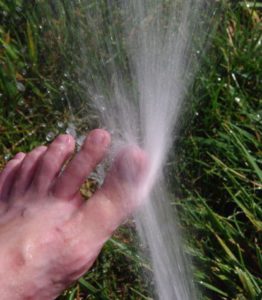 When temps hit the ’90s, lawns start to stress. That is because most of our Colorado lawns are bluegrass, a cool season grass which doesn’t much care for heat waves.
When temps hit the ’90s, lawns start to stress. That is because most of our Colorado lawns are bluegrass, a cool season grass which doesn’t much care for heat waves.
When we see lawns looking stressed – or even brown – it’s tempting to set the sprinklers to run longer. Yet lack of water may not be what’s causing those stressed areas and brown spots. If water from the sprinkler heads is not hitting the brown spots, then watering longer won’t turn that spot green.
The underlying problems could be simple fixes to sprinkler system flaws you don’t see because the system operates overnight. During a heat wave, the already stressed lawn will not be forgiving about any flaws in your system. On the other hand, making small repairs and adjustments this weekend could mean the difference between green grass and brown spots.
Here’s what you can do:
- Turn on the sprinkler system and watch every zone operate. Are the brown spots being watered?.
- Next, notice if heads are sitting straight up and down in the lawn. If they are pointed down instead of out and across the lawn, for example, the water won’t spray the whole area it’s supposed to reach. Re-positioning the heads will get the water headed in the right direction
- Is water hitting the sidewalk instead of the lawn? If so, the heads need to be adjusted so that the water is directed at the lawn. Sprinklers are mechanical devices – and like our cars, they need a little tinkering at times to be in good working order.
- Next, look for clogged nozzles. If the head is not spraying evenly or as strongly as other heads are, that could be debris inside the nozzle. A little grit may be all that stands between a green lawn and a brown spot. A quick nozzle cleaning can keep your lawn green.
When you set watering times, do so based on the kind of sprinkler heads:
- Pop-ups spray continuously in one area and should never run more than about 10 minutes at a time. If they spray longer, the water starts to run off because there is more water now than the soil can absorb.
- Rotor heads – that go back and forth – need longer run times because they are moving across the yard. But they, too, can also create runoff if operated more than about 20 minutes – and that’s water that doesn’t stay on your lawn that you’ll pay for.
If the lawn needs more water than one cycle can provide, add another watering time later so water has time to soak in between watering cycles. This cycle and soak method will prevent run-off and keep you from paying for water that literally goes down the drain.
Courtesy of ALCC Sustainable Landscape Partners
